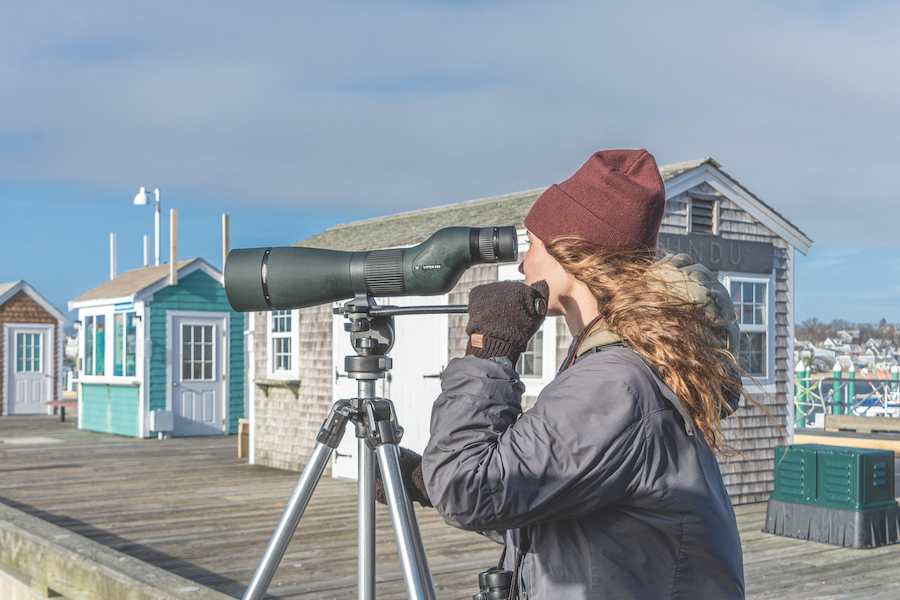I have written about the centrality of MacMillan Wharf to Provincetown. I would get no argument in the summer, certainly, or even the shoulder seasons. Ferries first disgorge people, who stream down the wharf into town with great expectations, then take on the exhausted, partied-out vacationers for the return trip to Boston. The whale watch boats are coming and going with screaming passengers and droning naturalists.
These boats seem to inhale and exhale people throughout the day. The scene includes the Hindu, the Bay Lady, the charter sport fishing boats, and a stream of strollers and sightseers. The pounding of footsteps in August is like the low rumble of thunder. There is a cacophony of languages from around the world — a modern-day Babel. And don’t forget the kids diving into the water. Pandemonium.

Winter activity on the wharf is less known. Less known, that is, unless you belong to a small but devoted group of nerds who celebrate birds. I am one of them. MacMillan Wharf is regularly visited on these short bleak winter days, in good weather and in bad, and most sightings are electronically communicated around the world (principally by something called eBird). So, if a rarity is sighted, as it recently was, the wharf turns into a mecca, with enthusiasts (sorry I called you “nerds”) coming from Boston, Connecticut, and beyond.
Birders show up for a rare bird on the wharf the way the gulls on the beach come out of nowhere when you appear with a bag of popcorn. And there is a genuine and gratifying sharing of sightings between complete strangers. (“Have you seen it? It’s over there by the orange buoy!”)
The recent rarity, beginning in December, was a black guillemot, which, in winter, is white. There were actually two guillemots, one whiter than the other — the extremely white bird is a member of an Arctic subspecies and is, I believe, a first record for the state. This was a big deal in Bird World.
Yes, we also have the ubiquitous loafing gulls (although even among them you can spot a rarity, like the lesser black-backed gull, a mainly European species that I saw last week) and scrambling pigeons (which are actually quite beautiful up close, if regarded without prejudice). But the long winter months also bring varieties of sea ducks and geese with wonderful names like goldeneye, long-tailed, bufflehead, eider, merganser, harlequin, and brant, loons, grebes, and a handful of alcid species (sometimes referred to as the “penguins of the Northern Hemisphere”) — murres, dovekies, razorbills, and guillemots.
All these birds come from up north. They think this place is Miami! And they literally are at your feet. MacMillan Wharf is, after all, a sizable artificial extension of land out into the harbor, and it is elevated. You are surrounded by a watery world, and it is full of water birds.
I visit the wharf almost every day to spend time with the birds. In this I am a throwback to the age-old custom of the fishermen, whether retired or on a rare day off, who would religiously come down to the wharf to see “what was up,” what the weather and seas were like, and who was catching what. Veteran whale watch workers do the same in their season.
Standing at the end of the wharf, under pewter skies, Long Point out beyond and the town behind me, under the gaze of the giant portraits of Portuguese women (“They Also Faced the Sea”) out on Fisherman’s Wharf, I survey the water with binoculars and spotting scope. I scan the breakwater and the few floats. I investigate the handful of docked fishing boats, and the relatively sheltered waters between the wharves and between the slips. The new wave attenuator is already attracting birds.
There is not much human activity most days. It is quiet, save for the emblematic cry of the gulls. A few lobster traps are piled up. At my feet is the detritus of unloaded fishing boats, the occasional twist of line, copious amounts of gull poop, and a few empty nip bottles. The cold air has that essence of fish, seaweed, salt, cold, and wet wood.
Wildlife is where you find it. And here, in the middle of town, where land meets sea, is a great place to experience the world. May it ever be so.



